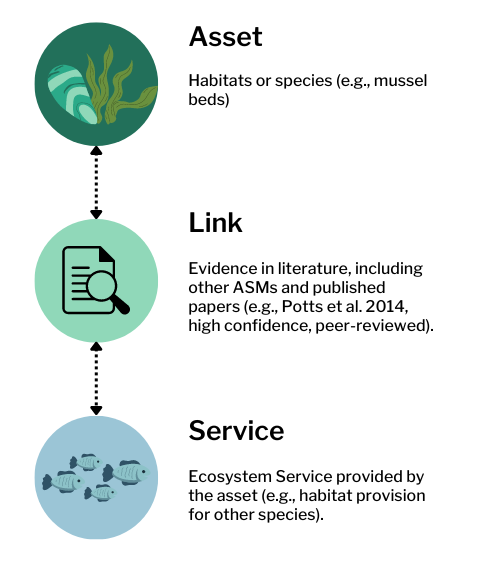
 Universal Asset Service Matrix (uASM)
Universal Asset Service Matrix (uASM)
Welcome to the Universal Asset Service Matrix (uASM). The uASM is a new tool to support marine natural capital approaches in the UK.
What is an Asset Service Matrix
Natural Capital aims to understand the value of nature and integrate it into the decisions we make within our economy and society. An Asset Service Matrix (ASM) describes and catalogues linkages between natural assets (habitats and species) and the ecosystem services that they provide.

ASMs serve a dual purpose in storing information about the linkages between Assets and Ecosystem Services (ES) as well as providing a visual summary of this information. There are several ASMs in the published literature, which use a variety of classification systems with different methodologies. While at their core all ASMs perform the same function, they are difficult to compare at present. Their differences hamper comparative work and larger-scale join-up in understanding ES delivery across assets.
Benefits of a uASM
The Joint Nature Conservation Committee (JNCC) has produced this standardised universal ASM (uASM) tool to make assets and their ecosystem services more accessible and available to a wider audience. This tool stores data from existing ASMs and the wider literature in a standardised format. The standardisation within the uASM allows users to export data into any commonly used habitat or ecosystem service classification and enables the creation of bespoke ASMs for specific contexts.
Users can contribute their own ASMs through the contribution section of the uASM web pages. The uASM currently contains over over 11,800 documented Asset-ES linkages and continues to grow, demonstrating the wide range of ESs delivered by UK marine habitats. Importantly, the uASM is designed to be iterative, with further evidence added by users as it emerges. This will ensure that the uASM remains a relevant tool for marine natural capital approaches across the wider marine ecosystem science, management, policy, and conservation community.
If you have feedback about the uASM’s design or content, or suggestions for future feature developments, please contact the team at assetservicematrix@jncc.gov.uk. If you’d like to sign up to receive updates regarding the uASM or the Marine Natural Capital Programme, please sign up for our mailing list.
uASM contents
All uASM data has been standardised using these four key categories:
JNCC Ecosystem Service Supply Score
This score estimates the level of service provision by an asset. Scores are taken from the original literature and converted into high, medium, low, and negligible service scores. The level of service provision is a relative rank only with no numerical value.
JNCC Confidence Score
We use a High-Medium-Low confidence score to allow users to make quick, informed decisions about the data available. This is achieved either by converting the confidence score from the original ‘parent’ ASM or by broadly assessing the literature source. High scores are given to primary, peer reviewed information and lowest scores to linkages based on personal communications or single expert judgements. Beyond this, users are responsible for making their own judgements about the quality of individual linkages.
Standardised Ecosystem Service Classifications using CICES
The Common International Classification of Ecosystem Services (CICES) V5.1 (https://cices.eu) is used as the base classification. All of the ecosystem service classification systems added into the uASM are then linked to their equivalent CICES code to allow quick comparison of data between different ASMs.
Standardised Asset Classifications
- Mobile Species and Low Mobility Species names are standardised with the World Register of Marine Species (WoRMS) (WoRMS - World Register of Marine Species). The WoRMS AphiaID acts as a unique taxonomic identifier and allows the user to search the uASM using both scientific and common species names.
- The uASM also links to a range of commonly used habitat codes including the JNCC’s MHCBI (Marine Habitat Classification System for Britain and Ireland) 2022 and the European Nature Information System (EUNIS) Habitat classification. At present, outputs can be viewed using both EUNIS 2007 and JNCC 97.06. EUNIS 2022 and JNCC 22.04 will be added shortly.
Use of the uASM
The universal Asset Service Matrix (uASM) (electronic dataset) is licensed under the Open Government Licence 3.0. © The universal Asset Service Matrix (uASM), JNCC, 2023.
If you use any of the data provided in the uASM, you must acknowledge the source of the information in your product or application by including, or linking to, the following attribution:
“Contains data provided by the universal Asset Service Matrix (uASM) (electronic dataset) © The universal Asset Service Matrix (uASM), JNCC, 2023".
Furthermore, any publication (e.g. article, book, report, presentation, or website) that uses or refers to the data provided, or a product based on the data or information provided, should include the following citation:
Cordingley A., Anderson L., Matthews S., Beach M., Molloy L., Whittaker L., Van Rein H., McNulty J., Reeve N., Parsons J. & Morgan V., 2023. The universal Asset Service Matrix (uASM). electronic dataset. Marine Life Information Network. Plymouth: Marine Biological Association of the United Kingdom. Joint Nature Conservation Committee. [Cited insert date] Available from https://www.marlin.ac.uk/asm
When referring to specific linkages please cite the original source.
Contact Us
We are continually updating the user experience. If you have any questions or would like to provide feedback on the uASM you can contact us at:
assetservicematrix@jncc.gov.uk
Search the uASM Contribute to the uASM


